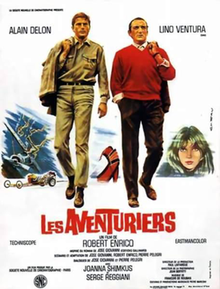Les aventuriers (1967 film)
| The Last Adventure | |
|---|---|
 |
|
| Directed by | Robert Enrico |
| Produced by | Gérard Beytout René Pignières |
| Screenplay by |
Robert Enrico José Giovanni Pierre Pilegri |
| Based on | novel by Jose Giovanni |
| Starring |
Alain Delon Lino Ventura |
| Music by | François de Roubaix, arranged by Bernard Gérard (first assistant) |
| Cinematography | Jean Boffety |
|
Production
company |
Societe Nouvelle De Cinematographic Productions
|
| Distributed by | Universal Pictures |
|
Release date
|
|
|
Running time
|
113 minutes |
| Country |
France Italy |
| Language | French |
| Box office | 3 120 412 admissions (France) |
The Last Adventure (French: Les Aventuriers) is a 1967 drama film directed by Robert Enrico. It is based on a novel by José Giovanni.
Three very likeable losers fail while they pursue individual goals. Roland Darbont (Lino Ventura) is an inventor who has designed his own engine. Manu Borelli (Alain Delon) on the other hand is a pilot who prepares a spectacular stunt. Both of them are running tests on Darbont's premises when they are joined by Laetitia Weiss (Joanna Shimkus), an artist who builds abstract statues from scrap metal. They nourish each other's hopes and learn to get along with each other.
But then Darbont's test vehicle blows up and nearly kills him. The damage is so grave that he has neither the means nor the will to start all over. Manu Borelli cannot execute his dangerous stunt. He loses his license as a pilot and it even turns out that he had fallen for a practical joke and won't receive any payment. Laetitia seems to succeed when she gets her art exhibition, still she can't sell a piece.
The three of them decide to take a yacht and go treasure hunting off the coast of Africa. A man stows away on board and tells them some treasure in the area - the result of a plane crash following people fleeing from the troubles in the Congo. The four of them decide to look for it together.
They discover the treasure. Laetitia tells Roland that she wants to live with him.
A patrol boat arrives and a gun fight ensues. Laetitia is killed in the cross fire.
Roland and Manu then visit Laetitia's family and pay them her share of the treasure.
There is a shoot out at the end where Manu is mortally wounded.
The film is partly shot on relatively exotic locations. Especially Fort Boyard deserves to be mentioned. Like the Maginot line in Crimson Rivers II: Angels of the Apocalypse (2004) it becomes the stage of a final showdown. Both films are in a way memorials for remarkable French accomplishments which are otherwise in main interesting for historians and military experts only.
The film was popular at the French box office, being one of Delon's biggest hits of the 1960s.
...
Wikipedia
